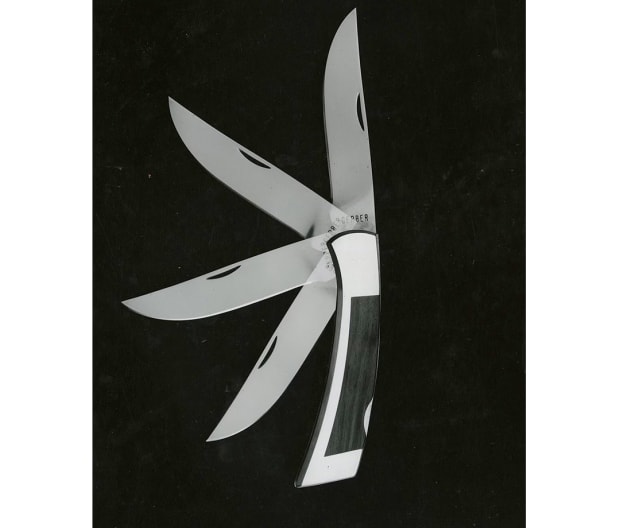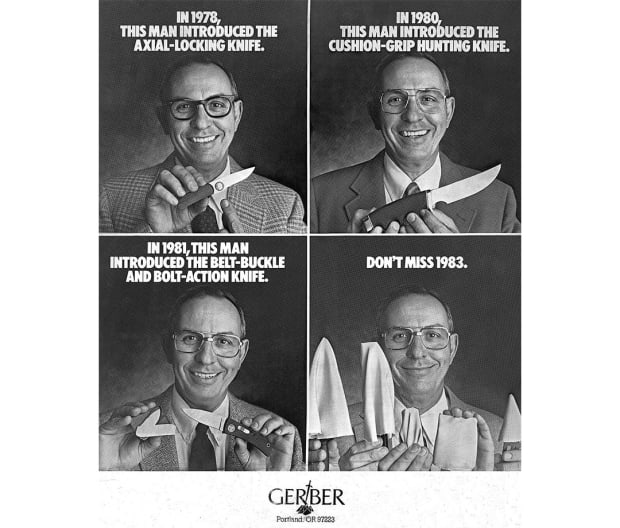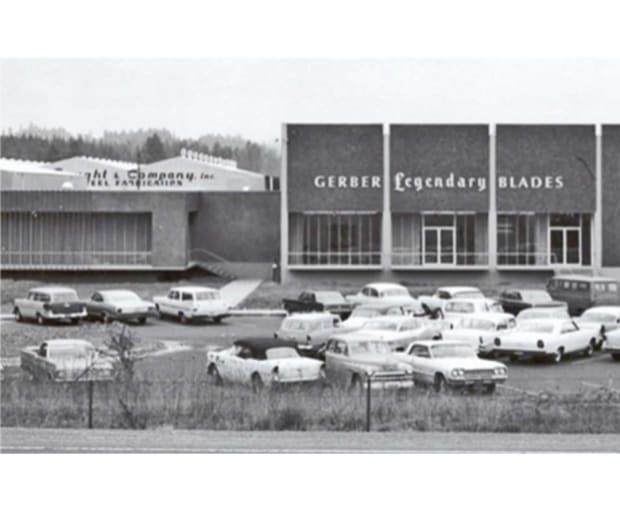Gerber makes some of the most reliable knives and multi-tools for the outdoors. Here's how it achieved meteoric success.
This article was produced in partnership with Gerber Gear
“It’s beat to hell, but it’s a classic,” says Keith Carrato, vice president of Gerber Gear. He’s not talking about a classic sports car, but rather a knife that was handed down to him by his father. The sentiment and significance are all the same. It’s a Gerber Sportsman II, a folding pocketknife with a locking blade and a wooden inlay handle that was made in the 70s.
“I have vivid memories of my father wearing that knife on his belt,” Carrato recalls.
He keeps the Sportsman II on his desk at Gerber’s headquarters in Portland, OR. It was a reliable everyday blade for his father then. Now it’s an heirloom that serves as a constant reminder of the legacy Gerber Gear established.
“I grew up with this brand,” Carrato says. “A Gerber was always on my father’s hip. When my brother went to South America to explore the Amazon, he bought himself a Gerber Gator fixed blade knife.”
Today, Gerber makes some of the most trusted, reliable knives and tools for the outdoors, from foldable shovels to multi-tools.
“We know there’s a Gerber in more camping and hunting kits than we could possibly imagine," Carrato adds. "I’m proud of our roots—what that brings to the table.”

Courtesy Image
A one-off turned national operation
The brand was founded in 1939 when Joseph Gerber, the owner of a printing company and advertising agency, partnered with knifemaker David Murphy to create custom kitchen carving knives for his clients. Abercrombie and Fitch, which was a popular New York-based outfitter at the time, got ahold of a set of those blades and wanted more. They reached out to Joseph Gerber about making sets of knives for the store, and Gerber Legendary Blades, the company we now know as Gerber Gear (and colloquially shortened to just Gerber), was born.
Gerber was a small family operation for decades, handed down first from father to son, then from brother to brother. In the beginning, Gerber focused on carving knives, using recycled metals. They used old aluminum heads and pistons from auto repair shops for the handles and ground hacksaw blades into shape for blades. The knives were given mythological names. Balmung, a 14.25-inch carving knife, was named after a legendary sword from Norse mythology. The 9.75-inch Curtana cake knife was named after the ceremonial sword used to coronate British knights. Of course, there was an Excalibur, a 17-inch-long carving knife reserved for special occasions. Those knives were as beautiful as they were practical. In fact, Ron, a carving knife with two tines, is in the permanent collection of the Museum of Modern Art in New York City.
Gerber introduced its first hunting knife in 1947, its first fishing knife in the 60s and, by the 70s, the brand was focused primarily on making knives for the outdoors. In the ‘90s, Gerber started making multi-tools, not just for the general public, but for the military. At one point, the pliers-centric MP600 was the military’s No.1 multi-tool. Service members relied on the American-made, 14-feature tool in the toughest situations all over the world, underscoring Gerber’s focus on quality. The tools being produced might have changed, but the purpose of the brand has remained the same.
"Everything starts with solving a consumer problem,” Carrato says. “We spend a lot of time obsessing over potential problems in the outdoors and how we can meet those needs. Everything we design is put through that lens.”

Courtesy Image
An ode to the past with all eyes on the future
Regardless of where innovation takes the company, the present and future of Gerber are intrinsically tied to its past. The company is part of the international Fiskars Group now, but the headquarters are still in Portland, where it was originally founded.
Likewise, every tool is still designed and tested in the Pacific Northwest. Carrato even occupies the same office used by Pete Gerber, who ran the company for two decades after his brother, “Ham” Gerber, passed it down to him. There’s a small room on the floor above that office that acts as a physical reminder of Gerber’s long tenure. It’s an archive of sorts, with cabinets and drawers full of knives and tools that Gerber’s made since its inception. Carrato finds himself lingering in that room often.
“I’ve lost hours of my life sitting in that archive, handling the knives and disappearing into the brand’s heritage,” he says.
He’s in awe of the innovation that can be traced back through the tools, from the Center-Drive that defines its current multi-tools to the locking systems on its original folding blades. Gerber continues to innovate, not just with the design of its tools (there are 74 active patents), but in how those tools are made.
Gerber’s flagship Portland manufacturing facility, where many of its knives and tools are crafted, operates as a zero-waste facility. The building runs on 100 percent renewable energy and everything gets recycled, down to the safety equipment workers wear. That production facility is forward thinking but the emphasis on sustainability is also a nod to the company’s scrappy and efficient past. Just as Joseph Gerber made his first knives out of recycled metals, so does Gerber’s Portland Facility: up to 80 percent of the steel used has been recycled.

Courtesy Image
“We take sustainability seriously,” Carrato says. “We’re proud of that facility, but the most sustainable thing we do is make a quality tool that doesn’t break. We put a lifetime guarantee on everything, whether it costs $9.99 or $189. I want you to have that knife for a really long time.”
The Portland facility is just another example of how Gerber honors its past while looking to the future. Take the new limited-edition Heritage Fastball: The modern-day sportsman pocket knife celebrates Gerber’s 84-year history with an aircraft-grade aluminum handle emblazoned with the company’s iconic sword and stone logo, and lasermarks that mimic the original Gerber packaging.
It’s among the best pocket knives in the market for innovation, quality, and price. Because of this, Fastball is now available in Gerber's Custom Shop and part of its Online Limited Edition designs.
“At the end of the day, the knife might be the oldest tool on Earth,” Carrato says. “It needs to do the same thing it did when cavemen were shaping rocks into sharp edges. That’s what’s been consistent for Gerber over our 84 years. The ability to deliver on that cannot change.”
from Men's Journal https://ift.tt/Wo837FE


0 comments